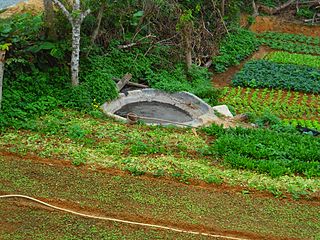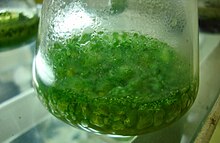
A fertilizer or fertiliser is any material of natural or synthetic origin that is applied to soil or to plant tissues to supply plant nutrients. Fertilizers may be distinct from liming materials or other non-nutrient soil amendments. Many sources of fertilizer exist, both natural and industrially produced. For most modern agricultural practices, fertilization focuses on three main macro nutrients: nitrogen (N), phosphorus (P), and potassium (K) with occasional addition of supplements like rock flour for micronutrients. Farmers apply these fertilizers in a variety of ways: through dry or pelletized or liquid application processes, using large agricultural equipment or hand-tool methods.

In agriculture, a green manure is a crop specifically cultivated to be incorporated into the soil while still green. Typically, the green manure's biomass is incorporated with a plow or disk, as is often done with (brown) manure. The primary goal is to add organic matter to the soil for its benefits. Green manuring is often used with legume crops to add nitrogen to the soil for following crops, especially in organic farming, but is also used in conventional farming.

Heterocysts or heterocytes are specialized nitrogen-fixing cells formed during nitrogen starvation by some filamentous cyanobacteria, such as Nostoc, Cylindrospermum, and Anabaena. They fix nitrogen from dinitrogen (N2) in the air using the enzyme nitrogenase, in order to provide the cells in the filament with nitrogen for biosynthesis.
Diazotrophs are bacteria and archaea that fix atmospheric nitrogen(N2) in the atmosphere into bioavailable forms such as ammonia.

Soil fertility refers to the ability of soil to sustain agricultural plant growth, i.e. to provide plant habitat and result in sustained and consistent yields of high quality. It also refers to the soil's ability to supply plant/crop nutrients in the right quantities and qualities over a sustained period of time. A fertile soil has the following properties:

Organic fertilizers are fertilizers that are naturally produced. Fertilizers are materials that can be added to soil or plants, in order to provide nutrients and sustain growth. Typical organic fertilizers include all animal waste including meat processing waste, manure, slurry, and guano; plus plant based fertilizers such as compost; and biosolids. Inorganic "organic fertilizers" include minerals and ash. The organic-mess refers to the Principles of Organic Agriculture, which determines whether a fertilizer can be used for commercial organic agriculture, not whether the fertilizer consists of organic compounds.
Agrogeology is the study of the origins of minerals known as agrominerals and their applications. These minerals are of importance to farming and horticulture, especially with regard to soil fertility and fertilizer components. These minerals are usually essential plant nutrients. Agrogeology can also be defined as the application of geology to problems in agriculture, particularly in reference to soil productivity and health. This field is a combination of a few different fields, including geology, soil science, agronomy, and chemistry. The overall objective is to advance agricultural production by using geological resources to improve chemical and physical aspects of soil.

The phosphorus cycle is the biogeochemical cycle that involves the movement of phosphorus through the lithosphere, hydrosphere, and biosphere. Unlike many other biogeochemical cycles, the atmosphere does not play a significant role in the movement of phosphorus, because phosphorus and phosphorus-based materials do not enter the gaseous phase readily. The production of phosphine gas occurs in isolated and specific conditions. Therefore, the phosphorus cycle is primarily viewed through terrestrial and aquatic ecosystems.

Rhizobacteria are root-associated bacteria that can have a detrimental, neutral or beneficial effect on plant growth. The name comes from the Greek rhiza, meaning root. The term usually refers to bacteria that form symbiotic relationships with many plants (mutualism). Rhizobacteria are often referred to as plant growth-promoting rhizobacteria, or PGPRs. The term PGPRs was first used by Joseph W. Kloepper in the late 1970s and has become commonly used in scientific literature.
Microbial inoculants also known as soil inoculants or bioinoculants are agricultural amendments that use beneficial rhizosphericic or endophytic microbes to promote plant health. Many of the microbes involved form symbiotic relationships with the target crops where both parties benefit (mutualism). While microbial inoculants are applied to improve plant nutrition, they can also be used to promote plant growth by stimulating plant hormone production. Although bacterial and fungal inoculants are common, inoculation with archaea to promote plant growth is being increasingly studied.

Agricultural pollution refers to biotic and abiotic byproducts of farming practices that result in contamination or degradation of the environment and surrounding ecosystems, and/or cause injury to humans and their economic interests. The pollution may come from a variety of sources, ranging from point source water pollution to more diffuse, landscape-level causes, also known as non-point source pollution and air pollution. Once in the environment these pollutants can have both direct effects in surrounding ecosystems, i.e. killing local wildlife or contaminating drinking water, and downstream effects such as dead zones caused by agricultural runoff is concentrated in large water bodies.
Phosphate rich organic manure is a type of fertilizer used as an alternative to diammonium phosphate and single super phosphate.
Agricultural microbiology is a branch of microbiology dealing with plant-associated microbes and plant and animal diseases. It also deals with the microbiology of soil fertility, such as microbial degradation of organic matter and soil nutrient transformations.

Manure is organic matter that is used as organic fertilizer in agriculture. Most manure consists of animal feces; other sources include compost and green manure. Manures contribute to the fertility of soil by adding organic matter and nutrients, such as nitrogen, that are utilised by bacteria, fungi and other organisms in the soil. Higher organisms then feed on the fungi and bacteria in a chain of life that comprises the soil food web.

Phosphate solubilizing bacteria (PSB) are beneficial bacteria capable of solubilizing inorganic phosphorus from insoluble compounds. P-solubilization ability of rhizosphere microorganisms is considered to be one of the most important traits associated with plant phosphate nutrition. It is generally accepted that the mechanism of mineral phosphate solubilization by PSB strains is associated with the release of low molecular weight organic acids, through which their hydroxyl and carboxyl groups chelate the cations [an ion that have positive charge on it.] bound to phosphate, thereby converting it into soluble forms. PSB have been introduced to the Agricultural community as phosphate Biofertilizer. Phosphorus (P) is one of the major essential macronutrients for plants and is applied to soil in the form of phosphate fertilizers. However, a large portion of soluble inorganic phosphate which is applied to the soil as chemical fertilizer is immobilized rapidly and becomes unavailable to plants. Currently, the main purpose in managing soil phosphorus is to optimize crop production and minimize P loss from soils. PSB have attracted the attention of agriculturists as soil inoculums to improve the plant growth and yield. When PSB is used with rock phosphate, it can save about 50% of the crop requirement of phosphatic fertilizer. The use of PSB as inoculants increases P uptake by plants. Simple inoculation of seeds with PSB gives crop yield responses equivalent to 30 kg P2O5 /ha or 50 percent of the need for phosphatic fertilizers. Alternatively, PSB can be applied through fertigation or in hydroponic operations. Many different strains of these bacteria have been identified as PSB, including Pantoea agglomerans (P5), Microbacterium laevaniformans (P7) and Pseudomonas putida (P13) strains are highly efficient insoluble phosphate solubilizers. Recently, researchers at Colorado State University demonstrated that a consortium of four bacteria, synergistically solubilize phosphorus at a much faster rate than any single strain alone. Mahamuni and Patil (2012) isolated four strains of phosphate solubilizing bacteria from sugarcane (VIMP01 and VIMP02) and sugar beet rhizosphere (VIMP03 and VIMP 04). Isolates were strains of Burkholderia named as VIMP01, VIMP02, VIMP03 and VIMP04. VIMP (Vasantdada Sugar Institute Isolate by Mahamuni and Patil) cultures were identified as Burkholderia cenocepacia strain VIMP01 (JQ867371), Burkholderia gladioli strain VIMP02 (JQ811557), Burkholderia gladioli strain VIMP03 (JQ867372) and Burkholderia species strain VIMP04 (JQ867373).
Soil microbiology is the study of microorganisms in soil, their functions, and how they affect soil properties. It is believed that between two and four billion years ago, the first ancient bacteria and microorganisms came about on Earth's oceans. These bacteria could fix nitrogen, in time multiplied, and as a result released oxygen into the atmosphere. This led to more advanced microorganisms, which are important because they affect soil structure and fertility. Soil microorganisms can be classified as bacteria, actinomycetes, fungi, algae and protozoa. Each of these groups has characteristics that define them and their functions in soil.

Mycorrhiza helper bacteria (MHB) are a group of organisms that form symbiotic associations with both ectomycorrhiza and arbuscular mycorrhiza. MHBs are diverse and belong to a wide variety of bacterial phyla including both Gram-negative and Gram-positive bacteria. Some of the most common MHBs observed in studies belong to the phylas Pseudomonas and Streptomyces. MHBs have been seen to have extremely specific interactions with their fungal hosts at times, but this specificity is lost with plants. MHBs enhance mycorrhizal function, growth, nutrient uptake to the fungus and plant, improve soil conductance, aid against certain pathogens, and help promote defense mechanisms. These bacteria are naturally present in the soil, and form these complex interactions with fungi as plant root development starts to take shape. The mechanisms through which these interactions take shape are not well-understood and needs further study.
Some types of lichen are able to fix nitrogen from the atmosphere. This process relies on the presence of cyanobacteria as a partner species within the lichen. The ability to fix nitrogen enables lichen to live in nutrient-poor environments. Lichen can also extract nitrogen from the rocks on which they grow.
Seventeen elements or nutrients are essential for plant growth and reproduction. They are carbon (C), hydrogen (H), oxygen (O), nitrogen (N), phosphorus (P), potassium (K), sulfur (S), calcium (Ca), magnesium (Mg), iron (Fe), boron (B), manganese (Mn), copper (Cu), zinc (Zn), molybdenum (Mo), nickel (Ni) and chlorine (Cl). Nutrients required for plants to complete their life cycle are considered essential nutrients. Nutrients that enhance the growth of plants but are not necessary to complete the plant's life cycle are considered non-essential, although some of them, such as silicon (Si), have been shown to improve nutrent availability, hence the use of stinging nettle and horsetail macerations in Biodynamic agriculture. With the exception of carbon, hydrogen and oxygen, which are supplied by carbon dioxide and water, and nitrogen, provided through nitrogen fixation, the nutrients derive originally from the mineral component of the soil. The Law of the Minimum expresses that when the available form of a nutrient is not in enough proportion in the soil solution, then other nutrients cannot be taken up at an optimum rate by a plant. A particular nutrient ratio of the soil solution is thus mandatory for optimizing plant growth, a value which might differ from nutrient ratios calculated from plant composition.
Seaweed fertiliser is organic fertilizer made from seaweed that is used in agriculture to increase soil fertility and plant growth. The use of seaweed fertilizer dates back to antiquity and has a broad array of benefits for soils. Seaweed fertilizer can be applied in a number of different forms, including refined liquid extracts and dried, pulverized organic material. Through its composition of various bioactive molecules, seaweed functions as a strong soil conditioner, bio-remediator, and biological pest control, with each seaweed phylum offering various benefits to soil and crop health. These benefits can include increased tolerance to abiotic stressors, improved soil texture and water retention, and reduced occurrence of diseases.











